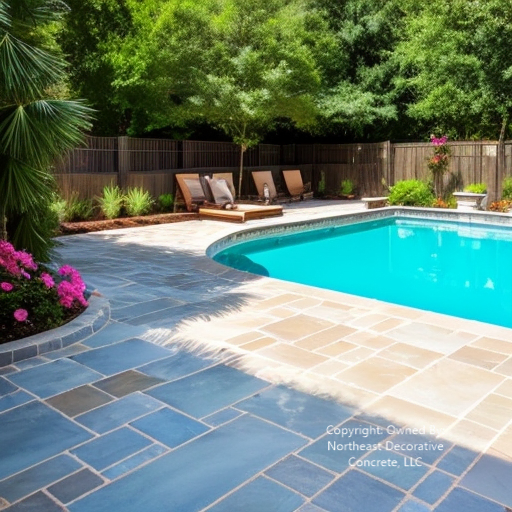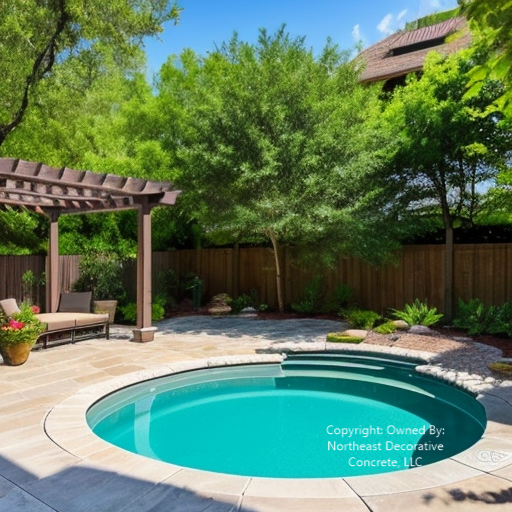
How Long To Wait Before and After Sealing Stamped Concrete?
So, you decided to install some fancy stamped concrete in your outdoor living space. Nice choice! Stamped concrete can transform dull gray concrete. It creates a decorative surface resembling slate, brick, stone, wood planking, or other textures.
Adding this eye-catching finish is just the first step, though. To keep your stamped concrete patio, pool deck, or driveway looking sharp for years, it’s crucial to seal it at the right time. Miss the timing before or after sealing, and you risk trapping moisture or letting the sealer wear off too fast.
It comes down to 2 options:
- You can use a cure-n-seal and apply it to the stamped concrete patio right away.
- Or you can wait twenty-eight days for the concrete to cure and dry out.
I’ve learned many things from my decades as a decorative concrete contractor. One of them is to seal that concrete patio as fast as you can. Unsealed concrete easily gets stained from boot marks, nasty weather, and animals walking across the slab. Also, most contractors pour in the summer heat. Using a cure and seal can slow down the heat cycle of the concrete. That’s what we do! We kill two birds with one stone. We use cure-n-seal within a few days after the pour, so it is protected and curing correctly.
Clear-coating stamped concrete sounds simple, but do it too soon or too late, and you can face problems. This article explains when to apply the clear coat to stamped concrete. It also describes how long to wait before and after using the clear coat to do it right.
Why Does a Concrete Driveway & Patio Need 28 Days to Cure?
Concrete needs twenty-eight days to allow excess moisture to evaporate entirely. This is the main reason for curing it. After it dries out, you can apply chemical reaction sealers, coatings, or other treatments.
Here is a summary of the curing process over twenty-eight days:
- Concrete starts mixed with a lot of water, which allows it to be poured and shaped initially. Over time, excess water evaporates out as concrete hardens.
- If sealers or coatings are applied too early, they can trap moisture below the surface. This moisture has nowhere to go as the sealer creates a waterproof barrier.
- Trapped moisture can cause damage like cracks, crumbling, and sealer peeling. This happens when the humidity tries to evaporate but can’t escape.
- To prevent moisture issues, it is standard practice to allow concrete to dry out for twenty-eight days. This allows nearly all excess moisture to evaporate so surface treatments can be applied.
- Over twenty-eight days, the concrete gains strength through a chemical process called hydration. But moisture evaporation, not strength gain, is the main reason for waiting to apply sealers.
In summary, the 28-day process allows concrete floors to dry out. This prevents moisture issues with future sealers, coatings, or other treatments. Almost all the moisture has evaporated. The concrete is ready for more applications after twenty-eight days.

Why Seal Stamped Concrete Anyway?
Before discussing the good condition timing, you might wonder why it’s so important to clear-coat a stamped concrete pool deck. Can’t you just let it be? Well, you could, but it likely won’t turn out well.
Unsealed stamped concrete is vulnerable to issues like:
- Fading colors
- Growth of moss and mildew
- Staining from oil, grease, food spills, etc.
- Damage from salt, chemicals, and sun exposure
- Crumbling and cracking over time
Applying a concrete sealer with 2 coats to stamped concrete protects the concrete from weathering, wear, and contamination. The sealer forms a protective barrier on the surface.
Sealing also enhances the look of stamped concrete by:
- Intensifying the colors
- Giving it a glossy, wet sheen
- Hiding minor imperfections
Sealing is vital to preserving your investment in stamped concrete. It’s essential for both function and aesthetics.
Wait Time Before Sealing New Stamped Concrete
The most crucial wait time is letting a new stamped concrete driveway fully dry out. Then, you can clear-coat it. If the sealer is applied too soon, disaster can strike down the road.
Here’s why:
When a concrete surface dries out, excess moisture evaporates from the mix. Also, sealing concrete too early after pressure washing traps moisture below the surface. Later, when temperatures drop, this moisture can expand and cause damage like:
- Flaking off the sealer
- Pitting and spalling in the concrete
- Cracks and crumbling
Major bummer! General guidelines say to wait at least twenty-eight days after installation to seal stamped concrete. This allows the concrete to be fully cured.
Hot tip: Some specialty sealers called cure & seals can be used sooner than 28 days. These let concrete keep drying out underneath the sealer. Ask your contractor for cure & seal UV ray product recommendations.
Waiting a whole month takes patience, for sure. But protecting your investment in stamped concrete is worth it!
While you wait, keep the surface clean and free of stains. Cover it to protect it from rain or snow if possible. And don’t let anyone drive or park vehicles on it until the clear protection coating is done.
When day 28 finally rolls around, celebrate by sealing your concrete’s glory!
Choosing the Right Types Of Concrete Sealers
With tons of topical sealers, how do you pick the right one? Consider:
Look: Do you want a natural flat matte finish or a glossy wet sheen?
Use: Will the surface need heavy traffic protection?
Budget: Higher-end, good-condition sealers usually last longer.
Your contractor can recommend the best types and brands for your project.
Some top options are:
- Acrylics: Budget-friendly, breathable sealers that let moisture escape.
- Epoxies: Super durable with a glossy finish but can turn yellow over time.
- Polyurethanes: Provide long-lasting wear protection with a wet look.
- Polyaspartics: Quick drying with excellent adhesion and abrasion resistance.
Always follow the manufacturer’s instructions for surface prep, application, dry time, and reapplication. This ensures the best results from your sealer.

The Post-Sealing Waiting Game
You picked the perfect type of sealer and sealed your stamped concrete just right. High five! But now comes more waiting before you can walk, drive, or party on your new surface.
Here’s a timeline of what you can expect:
- After this initial drying period, 12-48 hours: Safe for light foot traffic.
- 36 hours-7 days: Allow for vehicle traffic at this point.
- 7 days: Max hardness, durability, and water resistance are achieved. Use freely!
It’s tough to hold off using your gorgeous new stamped concrete sealer. But let that acrylic sealer fully penetrate first. Early footprints, vehicle tires, and dragged furniture can imprint on the soft, penetrating sealer. They can also scratch it up. To ensure the longevity and appearance of your stamped concrete, it’s essential to allow adequate drying time. Generally, waiting at least 24 to 48 hours will give the sealer enough time to set before introducing any weight onto the surface. Remember, knowing when to drive on stamped concrete is crucial to avoid damage and maintain its beautiful finish for years to come.
Keep pets off the surface for 3-5 days too. Those puppy paws and kitty claws can do a number on fresh sealer!
Ongoing Reseal Stamped Concrete Care
Over time, even the best concrete sealer may show wear and need reapplication. How often depends on the product, but usually every 3-5 years.
Resealing maintains that like-new sheen and protection. Without it, the shine of your stamped concrete will gradually dull. The surface can start deteriorating again.
Before applying the sealer, always properly clean and prepare the existing concrete like when it was new. Pressure wash, repair cracks or flaws, and let it fully dry first.
To keep your stamped concrete looking its best for decades, stay on top of:
- Stay on top of resealing maintenance
- Quick cleaning of spills
- Removing snow and ice in winter
- Sweeping away dirt and leaves often
- Keeping heavy planters, furniture, etc., from scratching it
Let’s Recap Key Timing for Stamped Concrete Sealing
- Wait for twenty-eight days minimum after installation to clear-coat new stamped concrete.
- Use a cure & seal product to seal faster than 28 days.
- Select your sealer type based on looks, use, and budget.
- Wait 12-48 hours before light foot traffic after sealing.
- Allow 36 hours-7 days for vehicles on freshly clear-coated surfaces.
- Wait 7 days before heavy use.
- Reapply sealer every 3-5 years.
- Apply when the temps are between 50-90°F. Do not apply below 50°F or above 90°F.
Stick to these simple timeframes for clear-coating the surface of the concrete. You’ll enjoy gorgeous, protected results for years on end. Do you have any other questions about keeping your new concrete looking amazing? Reach out, and I’ll be happy to help!
Our Locations:
Nashua, NH
North Hampton, NH
Concord, NH
